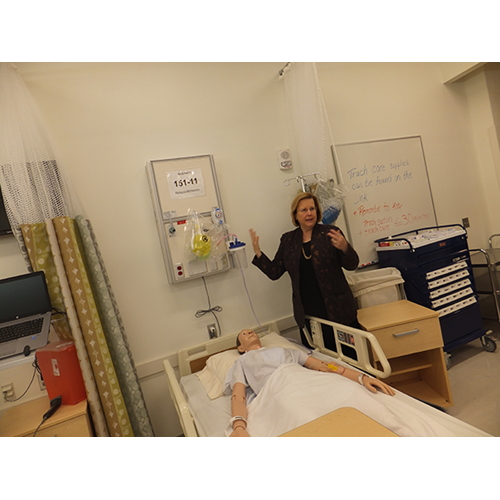New adventures for Nursing School Dean Vida Lock
In January, Interim Provost and Senior Vice President for Academic Affairs Jianping Zhu announced that Dr. Vida Lock, dean of the School of Nursing, will take on new responsibilities to serve CSU more broadly. She will lead interprofessional education (IPE) efforts and coordinate operations of the Center for Innovation in Medical Professions (CIMP) and, working closely with Dr. Edgar Jackson, co-director of the NEOMED-CSU Partnership for Urban Health, organize the integration of CSU health professions programs with the partnership. Dr. Lock will continue in the role of dean until June 30. Since Jan. 1, Associate Dean Corinne Wheeler has been overseeing the School of Nursing's day-to-day operations, with the assistance of Interim Associate Dean Pamela Rutar, to allow Lock to devote more of her energies to supporting these important University-wide health professions initiatives.
“Our School of Nursing would not be the outstanding academic unit that it is today without Dean Lock's strong leadership since 2008,” Zhu wrote in his letter to the CSU community. “A tireless champion for her students, faculty and staff, she doubled enrollment in the School of Nursing. She was the driving force behind creating state-of-the-art classrooms and simulation labs, improving clinical learning experiences and establishing a clinical faculty professional development program. She spearheaded the Nursing Education specialization within the Ph.D. in Urban Education program in the College of Education and Human Services. She also was a key member of the team that guided the new CIMP Building from drawing board to reality.”
Under the outstanding leadership of Lock since 2008, the School of Nursing has doubled enrollment, unveiled a suite of state-of-the-art classrooms and simulation labs and earned continuing accreditation from both the Commission on Collegiate Nursing Education and the Ohio Board of Nursing
Lock began her CSU career nearly four decades ago, when she started teaching nursing continuing education courses in 1978. Eight years later, she was named director of continuing education programs for nursing and health professions, a position she held until she assumed responsibility for the School of Nursing.
She took a few minutes to answer these questions for Viking Pride:
Did you work as a nurse in a hospital setting at any point in your career?
Yes, in several areas. My first job was in labor and delivery, which seemed apropos as Vida means life.
When you started at CSU teaching nursing continuing education in 1978, did you ever think would spend the next 38 years of your life here?
No. Not at all. I had aspirations to go on to other clinical nursing jobs. Although when I told one of my high school teachers I was going into nursing she said ‘Oh no, you have to be a teacher.’ We went round and round. Sometimes I think she’s probably rolling in her grave going ‘I told you so!’
Roughly how many students would you estimate that you have taught directly (as a teaching faculty member) and indirectly (as dean of the School of Nursing)?
Oh, I’ve never tried to count up numbers, rather I prefer to think about how many patients will be better cared for by the individuals whom I have taught. That would be thousands upon thousands. That’s the true essence of education—it allows you to positively influence people’s lives.
Broadly speaking, what is the most significant change you have observed in the nursing profession since you started your career?
The change in the independent role of nurses and the respect for the profession of nursing is, in my opinion, the most significant change. I believe that in the past people always valued nurses but they were rarely given sufficient credit for their contributions. The Affordable Care Act and the 2010 Institute of Medicine Report on the Future of Nursing have shown that nurses are central to this country's healthcare system. Nurses are now seen as true partners in health care rather than being viewed as the handmaidens they were long ago.
Looking ahead to trends in the nursing profession, which trends give you the most cause for hope and which give you cause for concern?
The trend toward interprofessional education is very positive. In the past, students in various health disciplines were educated in silos and then when they graduated people expected them to work together to take care of the same patients. It is now clear that each health profession is valuable and provides care for patients in a unique way. However the health disciplines overlap in some areas. Interprofessional education helps health professionals see their role on the healthcare team; it helps them improve communication with each other and in turn this results in significantly improved care of patients. You asked about concerns, and I would say that my concerns are the ever-escalating costs of healthcare and the huge numbers of people who still don't have access to appropriate care.
What are your top priorities in your new role?
There are two priorities. One, to really integrate all of the different health professions programs at Cleveland State, as well as the programs at NEOMED. We have been working on establishing interprofessional education. Now that I will hopefully have more time, I plan to put significant energy into moving interprofessional education much further along. The second goal is to truly make use of the potential of the new Center for Innovation in Medical Professions building. Having had the privilege of being involved in the design from day one, I am aware of what wonderful opportunities this learning environment provides. I'd like to ensure that the building, with all of its technology, is used to capacity. This space provides our students with opportunities for amazing experiences as they are preparing to be the future health professionals in their communities.

